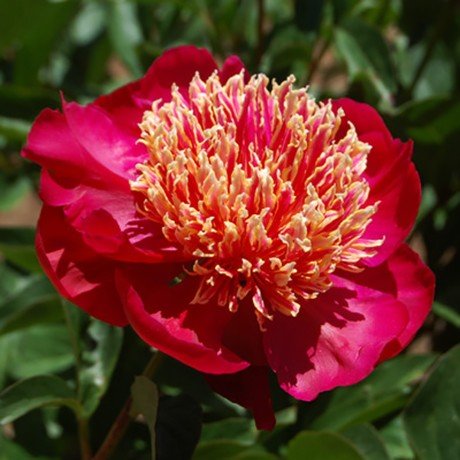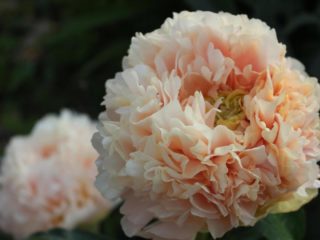Content
Peony Sword Dance is one of the brightest species, distinguished by very beautiful buds of dark crimson and red shades. It forms a fairly tall bush, the first flowers appearing 3-4 years after planting. It tolerates winter frosts well, so it can be grown not only in the Central part, but also in the Urals and Siberia.
Description of Peony Sword Dance
Sword Dance is a variety known since the early 1930s. It began to spread in Russia relatively recently. They are distinguished by very beautiful, lush flowers of bright red color. The bush is quite tall, up to 80 cm in height, peduncle up to 100 cm. Sun-loving, prefers open, well-lit areas. The stems are strong and powerful, so this type of peony does not need supports.

The foliage of Sword Dance is bright green, with a glossy surface, well accentuating the dark crimson flowers
In terms of winter hardiness, the Sword Dance peony is a resistant variety; it can withstand winter frosts down to -35 degrees, which allows it to be grown in different regions of Russia, including:
- Central part;
- Ural;
- Southern Siberia;
- Far East.
Features of flowering
In the description of the Sword Dance peony, special attention is paid to the flowers, since they are the ones who decorate the garden. These are bright red double buds with light yellow, graceful stamens. They are large in diameter and, with proper care, reach 17-20 cm. They give a light, fragrant aroma that is well felt, especially in calm weather.
Sword Dance peonies bloom magnificently even on not very fertile soils, but only if the minimum requirements are met:
- the area should be completely open, brightly lit;
- if possible, it should be protected from drafts;
- regular watering, the soil is always moist;
- Fertilizers are applied regularly, at least 3 times per season.

The flowering period of Sword Dance is average: peonies appear on the bushes in the second half of June - early July
Application in design
Thanks to the large, brightly colored flowers of a dark crimson hue, Sword Dance peonies are often used in single plantings. They are placed in the center of the flower garden, next to the entrance, bench, seating area and in other attractive places. They also look appropriate in compositions:
- in the flower beds;
- in mixborders;
- with dwarf conifers;
- in compositions with hosts.
Among plants and flowers, Sword Dance goes especially well with:
- forget-me-nots;
- decorative onions;
- crocuses;
- tulips;
- chrysanthemums;
- phlox;
- daisies;
- delphinium;
- heuchera;
- thuja;
- dwarf firs.

Sword Dance peonies look spectacular in single plantings
Reproduction methods
Sword Dance peonies can be grown in the same place for several years, up to 10 or more. But it is advisable to periodically replant overgrown bushes. You can propagate them:
- layering;
- cuttings;
- dividing the bush.
The latter method is considered the simplest and most effective - almost all cuttings successfully take root in a new place. It is better to start breeding the plant in early September, a month before frost. You need to do this:
- Shorten the lower stems by 1/3 of the length so that they do not break during division.
- Cut off a circle with a shovel and carefully remove the bush, being careful not to damage the roots.
- They wash away the soil with water pressure.
- Carefully inspect the rhizomes and cut them into several parts with a sharp knife.
- On each division there should be 3-5 buds and 2 root shoots.
- Rotten parts of the rhizome are cut off.
- They are transplanted to a new place at the same depth as the mother bush (the buds should be located no deeper than 3-5 cm from the surface).
- Water abundantly and mulch with peat and humus. In Siberia, you can additionally cover it with straw so that the Sword Dance peony seedlings survive the winter well.

It is better to propagate only adult Sword Dance bushes aged 4-5 years.
Landing rules
When purchasing a Sword Dance peony, pay special attention to the rhizomes. The roots must be healthy and have 3-5 normal buds, which will ensure good survival in the new location. They are planted at the end of August, and in the southern regions - around mid-September. When choosing a location, pay attention to the following points:
- openness, absence of even a faint shadow;
- protection from drafts;
- attractiveness of the place - preferably in the center of the garden, next to a gazebo, bench, pond.
Sword Dance peonies prefer light, moderately fertile soil with a neutral or slightly acidic reaction (pH from 5.5 to 7.0). If the soil is too acidic, you can add wood ash (200-300 g per 1 m2).
Before planting, the site is prepared several weeks in advance. It needs to be cleaned and dug up onto the bayonet of a shovel. Then form several large planting holes up to 1 m in diameter and up to 60 cm in depth (interval of about 1 m). If the site is located in a lowland, groundwater comes close to the surface, you will need to lay drainage from small stones with a layer of 5-7 cm at the bottom.
Then the soil is prepared - the following composition can be used as a basis (for 1 hole):
- 2 parts humus or compost;
- 1 part garden soil;
- 200 superphosphate;
- 60 g potassium salt.
The mixture is poured into the hole and the seedlings are rooted so that the buds are located no lower than 3-5 cm from the surface. Water abundantly and mulch with peat and humus.
Aftercare
Sword Dance peonies are quite easy to care for. It is important to ensure that the soil remains moderately moist:
- In the first season, water regularly - maybe 3 times a month with a bucket of water.
- In the second season, additional watering is given only during the dry period or if there is very little rain.
- The next day after watering, the soil is loosened so that the lumps do not stick together, which will cause the roots to receive less oxygen.
- Lay mulch from hay, straw or spruce branches - then the earth will remain well moistened for as long as possible.
Fertilizing is applied from the second year, at least 3 times per season:
- In early April - ammonium nitrate or urea.
- During the formation of buds (early June) - complex mineral fertilizer: either by root or foliar method.
- After flowering in mid-August, Sword Dance is fertilized with superphosphates and potassium salt.

Regular application of fertilizers and timely watering guarantee lush peony flowering
Preparing for winter
Since Sword Dance is characterized by fairly high winter hardiness, it does not need special preparation for frost. Usually in mid-September, a month before frost, gardeners carry out the following activities:
- The shoots are completely pruned to stimulate green growth and flowering next year.
- Treat with any fungicide.
- Cover with hay, straw or other mulch.
In the fall, there is no need to apply fertilizers - peonies must prepare for the winter period.
Pests and diseases
Sword Dance is resistant to diseases. But sometimes it is affected by viral and fungal infections:
- gray rot;
- powdery mildew;
- mosaic disease.
Pest invasion is also possible:
- aphid;
- ants;
- thrips.
To combat fungi, fungicides are used - Bordeaux mixture, Vintage, Profit, Spor. To kill insects, insecticides are used - “Biotlin”, “Decis”, “Karate”, “Green Soap”. It is also allowed to use folk remedies (solutions of soda, ammonia, infusion of onion peels and others).

To prevent the Sword Dance peony from suffering from diseases and insects, it is better to treat it in early autumn
Conclusion
Peony Sword Dance is a really bright, very beautiful flower.At the same time, it does not require special care conditions; it can be grown even on moderately fertile soil. If you provide it with basic conditions (lighting, watering and fertilizing), lush flowering is guaranteed.








